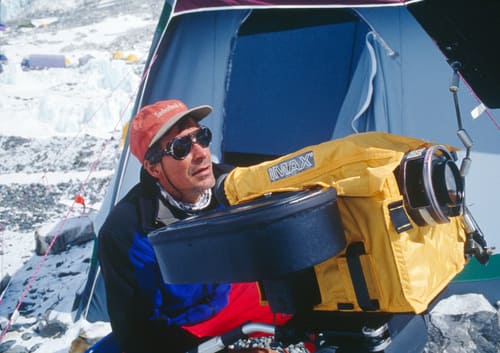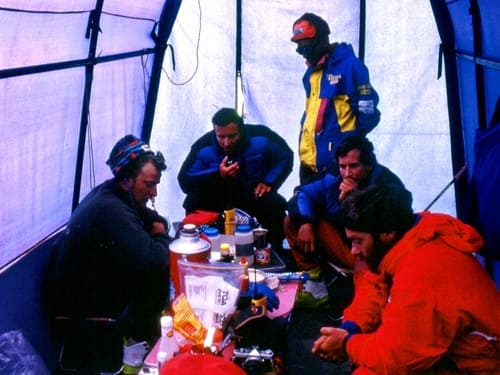Born on December 20, 1955, David Finlay Breashears is a renowned American mountaineer, filmmaker, author, and motivational speaker. His remarkable achievements include reaching the summit of Mount Everest for the second time in 1985, making him the first American to achieve this feat more than once. However, his fame largely stems from his role as the director and cinematographer of the highly successful IMAX documentary “Everest” (1998), which became the highest-grossing film of its kind.
During the production of “Everest,” an unfortunate disaster struck, and David Breashears played a pivotal role in the rescue efforts. Despite the challenges and dangers, he assisted in the efforts to save climbers during the infamous 1996 Everest disaster. This incident further highlighted his courage, compassion, and dedication to mountaineering and the people involved in the field.
Today, David Breashears is one of the most famous Mount Everest climbers and continues to inspire and motivate others through his motivational speaking engagements. He shares his incredible experiences and lessons learned from his extraordinary journeys as a mountaineer and filmmaker.
David Breashears: A Journey to the Summits

In 1983, Breashears sent the first live pictures from the top of Mount Everest. Then, in 1985, he became the first American to reach the summit of Everest more than one time. Up until September 2015, he had gone on eight expeditions to Everest, successfully reaching the summit five times.
When he was younger, he gained recognition in the climbing community for free climbing some of the most challenging rock walls in Colorado. One of his boldest achievements during that time was climbing the “Perilous Journey” on Eldorado Mountain in 1975, which was a short and difficult climb without any protective equipment.
In 1985, Breashears guided Richard Bass to the top of Everest, enabling Bass to achieve the incredible feat of completing the first-ever ascent of the Seven Summits.
From Summits to Screens
In addition to his climbing endeavors, David Breashears has made significant contributions to feature films, documentaries, and music videos. He worked on notable films like “Cliffhanger” (1993) and “Seven Years in Tibet” (1997), as well as the music video for David Lee Roth’s “Just Like Paradise.” He was involved in the award-winning TV documentary “Red Flag over Tibet” (October 20, 1989), for which he received four Emmy awards for cinematography.
Bringing together his passions for climbing, filmmaking, and photography, Breashears directed, starred in, and produced the acclaimed IMAX film “Everest” (1998). He also contributed still photos to the bestselling book “Everest: Mountain Without Mercy” (1977).

Further showcasing his talent in directing, he helmed the Nova television program “Everest” (1998), where he and fellow mountaineer Ed Viesturs climbed Everest while conducting tests to observe the effects of altitude on humans. Another notable work was the IMAX film “Kilimanjaro: To the Roof of Africa” (2000) for the National Geographic Society, documenting an expedition’s ascent of the world’s largest freestanding mountain in Tanzania.
One of Breashears’ gripping documentary films, “Storm Over Everest” (May 13, 2008), aired on PBS Frontline. The film features photography captured on the mountain and interviews with survivors of the 1996 storm that affected three climbing teams. The documentary also includes music composed by Jocelyn Pook. Interestingly, during the filming of this documentary in 2006, Breashears accomplished his fifth ascent of Everest. His personal reflections on climbing Everest again were documented in the “Epilogue to the 1996 Everest disaster,” a part of the Nova documentary.
Remembering the Tragic Night on 1996:

On May 10, 1996, a night of dread and disbelief descended upon the climbers on Mount Everest. For David Breashears, this tragedy struck close to the heart, leaving a profound impact that would stay with him forever.
The events began with the death of Taiwanese climber Chen Yu-Nan on the Lhotse Face. The day before, Chen had sustained injuries at Camp Three, and despite the best efforts of Sherpa guides to bring him to safety, he tragically passed away. It was a devastating blow, and the weight of the situation fell on Ed Viesturs and David Breashears, who were tasked with bringing Chen’s lifeless body down the mountain slopes. The memory of grappling with his body, lowering him over a steep ice cliff with a rope, left an indelible mark on them.
As the next day unfolded, news of the climbers’ delayed summit attempts reached their camp. The climbers had reached the summit much later than usual, and a sense of unease began to settle in. The situation took a dire turn when they learned that Rob Hall and Doug Hansen had summited Everest unusually late, around 4:30 in the afternoon. Alarmed and anxious, they received radio calls from Rob Hall, informing them that Doug had collapsed above the Hillary Step.
As if the situation wasn’t already fraught with difficulty, a storm began its ascent up the mountain, wreaking havoc and terrorizing the climbers throughout the night. The strong winds were relentless, leaving them anxious and fearful for their companions who had not returned to camp. The thought of fellow climbers exposed to the vicious storm outside, away from the safety of their tents, was unimaginable, shared Breashears.
Amidst this turmoil, a Sherpa woke up David early in the morning, beckoning him to Rob Hall’s communication tent. The look in the Sherpa’s eyes spoke sadness, and David knew that the situation had taken a grim turn. The night of May 10, 1996, would forever be etched in his memory as a night of loss, fear, and sorrow.
Against All Odds: The Triumph and Tragedy of Everest

On May 10, 1996, a notorious blizzard struck Mount Everest, resulting in the tragic loss of several climbers. During this challenging time, Breashears and his team were in the process of making their historic film on the mountain. Despite the unfolding disaster, they halted their filming to assist stranded climbers and ensure their safety. Their bravery and selflessness earned them recognition as heroes.
After the harrowing events, Breashears and his team regrouped and remained determined to achieve their goal of capturing IMAX film images from the summit. Finally, on May 23, 1996, they successfully reached the top of the world, becoming the first IMAX team to do so.
Reflecting on the tragedy, Breashears shared an important lesson: true success wasn’t just about reaching the summit but ensuring the survival of everyone on his team. Their ability to overcome the challenges and difficulties of Everest served as a powerful reminder that climbing the mountain was possible, and with the right preparation and determination, one could conquer it and come out alive.
David Breashears Publications
David Breashears has penned numerous books, among them his autobiography, “High Exposure: An Enduring Passion for Everest and Unforgiving Places” (1999), which provides a deep insight into his remarkable journey.
In addition to his books, he contributed an article titled “Every Man For Himself?” to the American Alpine Journal (1988), showcasing his expertise and thoughts on climbing and mountaineering.
Work with Organizations
David Breashears is actively involved with various organizations, each reflecting his passion for the Himalayas and his dedication to important causes.
He serves as a director of Destination Himalaya, a travel firm that specializes in organizing adventure travel to countries in the Himalayan region. Through this role, he shares his love for the majestic mountains with fellow travelers, allowing them to experience the wonders of the Himalayas firsthand.
In 2007, Breashears founded GlacierWorks, a non-profit company with a mission to raise awareness about climate change in the Greater Himalaya. Utilizing a combination of science, art, and adventure, GlacierWorks aims to shed light on the pressing environmental issues affecting the region. Through this initiative, Breashears uses his filmmaking and storytelling skills to emphasize the importance of preserving these magnificent mountains for future generations.
With his involvement in these organizations, David Breashears continues to make a significant impact in promoting adventure, preserving natural beauty, and addressing critical environmental challenges. His work exemplifies the power of combining passion and purpose to create positive change in the world.
David Breashears: An Inspiring Journey

David Breashears has ventured to the world’s highest peaks, capturing breathtaking imagery and sharing compelling stories through his filmmaking. From his pioneering achievements in mountaineering to his groundbreaking work in IMAX documentaries, Breashears has left a mark on the worlds of climbing and filmmaking.
As a visionary filmmaker, his films have not only captivated audiences but also shed light on the importance of preserving the delicate balance of our planet’s ecosystems.
In addition to his cinematic contributions, David Breashears’ dedication to mountaineering and adventure has inspired countless individuals to embrace their own aspirations and seek the extraordinary in the ordinary. His legacy extends beyond his accomplishments, reaching the hearts of those who dream of scaling new heights and pushing the boundaries of what is possible.
